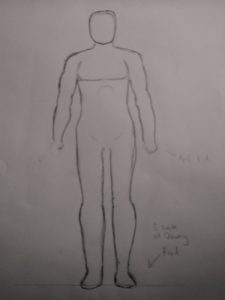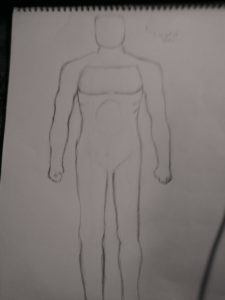Anthony Wu
Prof. Gwendolyn Shaw
Art 1010
12-04-18
Gian Lorenzo Bernini was an Italian sculptor and was well known for his sculptures In Italy. Gian Lorenzo Bernini was born in Naples and his own type of technique. He created the Baroque technique on his sculptors and many sculptors would follow or use this technique during this time period. He created a well known sculpture, which is Apollo and Daphne. Apollo and Daphne had a story within the sculpture and made a lot of people think of what is going. The sculptures that Bernini has made gives it a moving feeling to it. It’s like the sculpture is moving when you are walking around it. The Faun Teased by Children sculpture has a interesting and mysterious story. The creation and technique was essential in creating “The Faun Teased by Children” to become a fascinating art work in today’s’ period.
The Bacchanal: A Faun Teased by Children sculpture displays a man and three babies. The babies looks like cupids and other angelic child descendant from the religious catholic church. The man seems to be holding on the top of the tree. The tree is similar to the Apollo and Daphne sculpture. At first glance, I thought this was a continuous of the Apollo and Daphne sculpture story but they are separate. It has a similar resemblances to Apollo and Daphne because I thought the man was Apollo and Daphne was the tree. Also thought the cupids were the ones protecting Daphne from Apollo after she became a tree and hide from Apollo. I thought the cupids were pushing Apollo away from Daphne being the tree. Daphne’s father probably told the Cupids to watch over Daphne after she became a tree. This was my observation at first until I read the description of the sculpture. The sculpture had a different story than Apollo and Daphne by the same sculptor. Benini seems to sculpt people from greek gods or religious beliefs. Most of the stories about his sculptures would display a story or an imagination for the people looking at his art to think about. His sculptures shows a little movement within the structure because you can look at all of the points of view from any standings. His sculptures wants you to walk around and look at the sculptures on its significance details.
The man in the sculpture shows a follower of Bacchus. Bacchus was a god of wine and it shows one of the follower reaching to the tree. The trees show grapes on them and the Cupids or angels stopping him. It makes sense that the man was trying to get the grapes because wine is made out of dry grapes. The man was possibly trying to harvest the grapes and make wine out of it. He would return to Bacchus with a fresh bunch of wine from the grapes he picked earlier. The cupids tries to push him back and prevents him from getting the grapes. The sculpture also shows the same cupid pushing the man but the cupid next it is trying to resist. This could depict that both cupids are in differents sides or playing around with the man. It might also resemble the other cupids being a fallen angel and the other one being a good angel and pushing the fallen drunken man to stop. The sculpture may also show that the cupids are trying to the save the man life by stopping him from picking grapes and making wine out of it. I think the cupids are trying to tell the man that wine or any source of alcohol is bad for you. As a human being, drinking is bad for your health and people drinking is always natural because they drink traditional and maybe after their shift from work to get a drink. At the bottom of the sculpture shows a cupid at the bottom of his feet with a scared face that could mean the power of wine can lead to that face or it makes the cupid feel horrid. The Baroque technique displays a lot of details from different sides of the sculpture. His sculpture has that amazing motion that produce the drama more effectively than the other sculptures during the time period like Michelangelo. The Baroque technique was mostly used in Catholic churches because its shows divine and enlightenment feeling to the art or sculpture. I remember during the trip to MET, the painting that shows Mary carrying Baby Jesus. The painting shows Baroque technique making it look more realistic and in front of you like Bacchanal: A Faun Teased by Children.
I believe that this sculpture is great piece of art for today’s society because drinking is really bad habit and a lot of us drink for our relief and happiness. Drinking is a natural thing for people to do cultural but you can overdose from drinking. Drinking a lot can give side effects and shorten life. Drinking wine or alcohol means you are drinking to your death. I remember Socrates, a philosopher who liked to drink wine and other alcohol substances was killed from drinking poison. This shows that he loved to drink and didn’t look at what he was going to drink. This led to his death and it means you should drink responsibly instead of frequently. The sculpture model look very inspiring to most sculptor because the man in Bernini’s sculpture shows what superior man would look. A superior man would have a six-pack and would give eye contact to what’s in front of them. The six-pack shows a healthy man and strong strength during the 1600’s. In today’s society a six-pack would mean that person is fit and shows strength. Giving eye contact in Italy would depict the person is focus on what is in front of them like a problem that needs a situation to be solved. Eye contact in today’s society would show the person is respecting you and giving you attention. Bernini’s sculpture is like an influence to today’s society with a unique position with his sculptures.

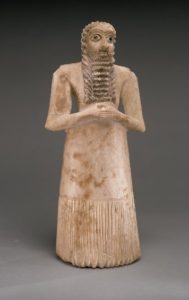 Artist: N/A
Title: Standing Male Worshiper
Date: 2900–2600 B.C.
Museum: The Metropolitan Museum of Art
As time began to progress so the idea of humanism began to form and the shift from making art that focused on deities and worshiping them to making art that worshiped humanity and focused on the ideal human body. An example of an artwork that showed the start of the transition from focus on deities to a focus on humans is the Statue of Kouros. Unlike the Standing Male Worshiper which had almost no detail on the human body, the Statue of Kouros focuses soley on the human body. It is a representation of a young nude male. The artist of this sculpture adds small but noticeable details such as the outlining of the mans abs and chest. Another faint but drastic difference between the two sculptures is the sense of movement that can be seen in the legs of the Statue of Kouros. As seen in the photograph below, the left leg of the statue strides forward giving the sculpture a feeling of movement.
Artist: N/A
Title: Standing Male Worshiper
Date: 2900–2600 B.C.
Museum: The Metropolitan Museum of Art
As time began to progress so the idea of humanism began to form and the shift from making art that focused on deities and worshiping them to making art that worshiped humanity and focused on the ideal human body. An example of an artwork that showed the start of the transition from focus on deities to a focus on humans is the Statue of Kouros. Unlike the Standing Male Worshiper which had almost no detail on the human body, the Statue of Kouros focuses soley on the human body. It is a representation of a young nude male. The artist of this sculpture adds small but noticeable details such as the outlining of the mans abs and chest. Another faint but drastic difference between the two sculptures is the sense of movement that can be seen in the legs of the Statue of Kouros. As seen in the photograph below, the left leg of the statue strides forward giving the sculpture a feeling of movement.
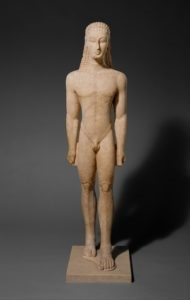 .
Artist: N/A
Title: Statue of Kouros
Date: 600 BCE
Museum: The Metropolitan Museum of Art
As more time passed the humanism movement became larger and lead to much more drastic changes in the art world. An example of a artwork that shows drastic a drastic change due to the humanism movement is the statue of Polykleitos. Similar to the statue of Kouros, the Doryphoros has a sense of movement but different to the Kouros, the Doryphoros has no symmetry. Instead the statue of Polykleitos has contrapposto. Contrapposto is the use of counter balancing to form "an asymmetrical arrangement of the human figure in which the line of the arms and shoulders contrasts with while balancing those of the hips and leg."(Google definition).By giving the statue contrapposto it the artist was able to show that the statue is suppose to represent a person walking.
.
Artist: N/A
Title: Statue of Kouros
Date: 600 BCE
Museum: The Metropolitan Museum of Art
As more time passed the humanism movement became larger and lead to much more drastic changes in the art world. An example of a artwork that shows drastic a drastic change due to the humanism movement is the statue of Polykleitos. Similar to the statue of Kouros, the Doryphoros has a sense of movement but different to the Kouros, the Doryphoros has no symmetry. Instead the statue of Polykleitos has contrapposto. Contrapposto is the use of counter balancing to form "an asymmetrical arrangement of the human figure in which the line of the arms and shoulders contrasts with while balancing those of the hips and leg."(Google definition).By giving the statue contrapposto it the artist was able to show that the statue is suppose to represent a person walking.
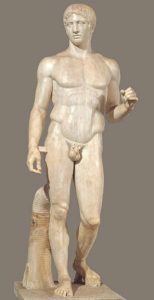 Artist: Polykleitos
Title: Doryphoros (Roman copy)
Date: 450-440 BCE
Museum: Museo Archaeologico Nazionale (Naples)
Artist: Polykleitos
Title: Doryphoros (Roman copy)
Date: 450-440 BCE
Museum: Museo Archaeologico Nazionale (Naples)






